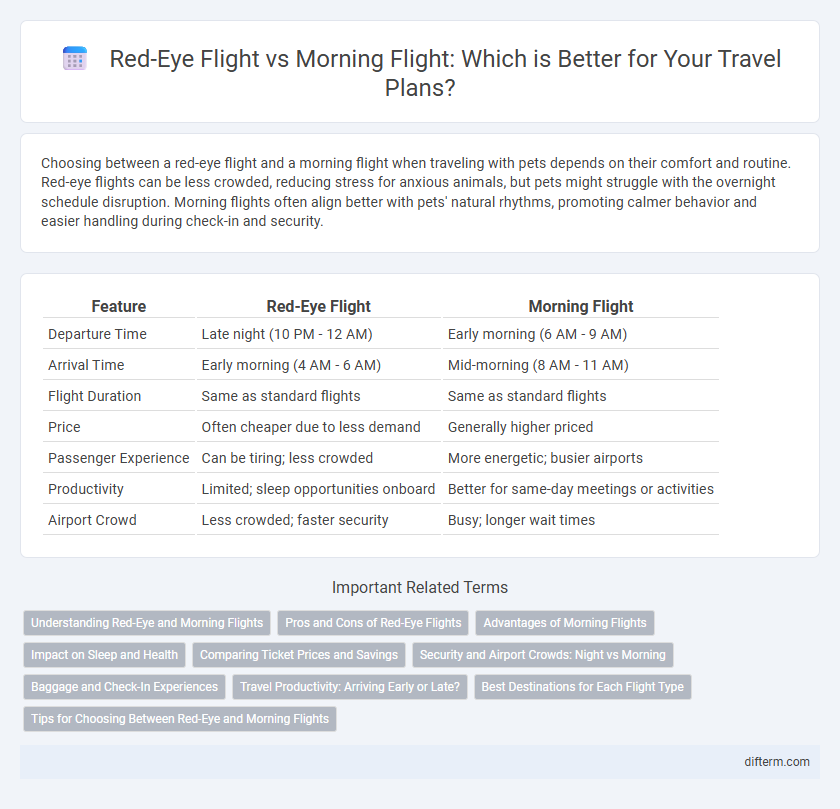Choosing between a red-eye flight and a morning flight when traveling with pets depends on their comfort and routine. Red-eye flights can be less crowded, reducing stress for anxious animals, but pets might struggle with the overnight schedule disruption. Morning flights often align better with pets' natural rhythms, promoting calmer behavior and easier handling during check-in and security.
Table of Comparison
| Feature | Red-Eye Flight | Morning Flight |
|---|---|---|
| Departure Time | Late night (10 PM - 12 AM) | Early morning (6 AM - 9 AM) |
| Arrival Time | Early morning (4 AM - 6 AM) | Mid-morning (8 AM - 11 AM) |
| Flight Duration | Same as standard flights | Same as standard flights |
| Price | Often cheaper due to less demand | Generally higher priced |
| Passenger Experience | Can be tiring; less crowded | More energetic; busier airports |
| Productivity | Limited; sleep opportunities onboard | Better for same-day meetings or activities |
| Airport Crowd | Less crowded; faster security | Busy; longer wait times |
Understanding Red-Eye and Morning Flights
Red-eye flights operate overnight, typically departing late at night and arriving early morning, allowing travelers to maximize daytime hours at their destination. Morning flights usually depart early in the day, offering a more traditional travel schedule but potentially requiring early wake-up times and less post-arrival rest. Choosing between red-eye and morning flights depends on factors such as personal sleep patterns, schedule flexibility, and the importance of arriving well-rested versus maximizing daytime productivity.
Pros and Cons of Red-Eye Flights
Red-eye flights offer travelers the advantage of saving daytime hours for activities and often come with lower ticket prices, making them cost-effective for budget-conscious passengers. However, these overnight flights can lead to fatigue and disrupted sleep patterns, which may impact productivity and overall travel experience upon arrival. Passengers should weigh convenience against the potential for exhaustion, especially when needing to be alert immediately after landing.
Advantages of Morning Flights
Morning flights offer several advantages, including higher on-time performance rates and lower chances of delays compared to red-eye flights, which often face disruptions due to limited airport staffing during nighttime hours. Passengers benefit from increased availability of ground transportation and amenities upon arrival, facilitating smoother onward travel. Additionally, flying in the morning allows for better adjustment to the local time zone, reducing jet lag and improving overall travel experience.
Impact on Sleep and Health
Red-eye flights often disrupt circadian rhythms, leading to sleep deprivation and increased fatigue due to overnight travel schedules. Morning flights, aligned more closely with natural sleep patterns, typically allow for better rest and reduced grogginess upon arrival. Consistent sleep disruption from red-eye flights may elevate stress levels and compromise immune function, impacting overall health negatively.
Comparing Ticket Prices and Savings
Red-eye flights typically offer lower ticket prices compared to morning flights, making them a cost-effective option for budget-conscious travelers. Savings can range from 10% to 30% depending on the airline and route, with fewer passengers opting for late-night departures. Choosing a red-eye flight can maximize budget efficiency without sacrificing the overall travel experience.
Security and Airport Crowds: Night vs Morning
Red-eye flights typically experience lower security wait times due to fewer travelers late at night, offering a faster airport experience compared to morning flights. Morning flights coincide with peak airport crowds and heightened security measures, leading to longer queues and potential delays. Choosing a red-eye flight can minimize exposure to crowded terminals and streamline the check-in and security process.
Baggage and Check-In Experiences
Red-eye flights often allow for quicker check-in and lighter baggage since passengers tend to travel with minimal luggage to avoid delays. Morning flights typically require earlier arrival for check-in and baggage drop-off, as airports experience higher passenger volumes and stricter security screenings. Choosing between red-eye and morning flights impacts the convenience of baggage handling and the overall check-in process efficiency.
Travel Productivity: Arriving Early or Late?
Choosing between a red-eye flight and a morning flight significantly impacts travel productivity; red-eye flights allow travelers to maximize daytime hours upon arrival, ideal for early meetings or events. Morning flights may provide better rest during travel, resulting in increased alertness and efficiency throughout the day. Evaluating individual sleep patterns and itinerary demands optimizes productivity when deciding the best option for timely engagement.
Best Destinations for Each Flight Type
Red-eye flights suit destinations like Los Angeles, New York, and London, allowing travelers to maximize daytime activities upon arrival. Morning flights are ideal for short-haul trips to cities such as San Francisco, Chicago, and Miami, where early arrival enables full-day exploration. Choosing the best flight depends on the destination's time zone, local attractions, and personal energy management.
Tips for Choosing Between Red-Eye and Morning Flights
Consider your personal sleep patterns and destination time zone when selecting between red-eye and morning flights to optimize rest and reduce jet lag. Red-eye flights often offer lower fares and less crowded airports, making them ideal for budget-conscious, flexible travelers. Morning flights typically provide better on-time performance and align with natural circadian rhythms, benefiting those needing alertness upon arrival.
red-eye flight vs morning flight Infographic

 difterm.com
difterm.com